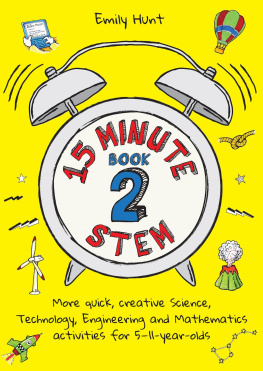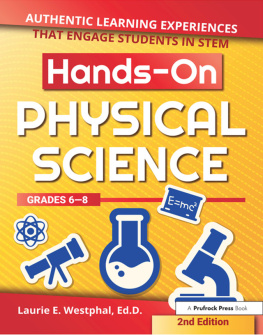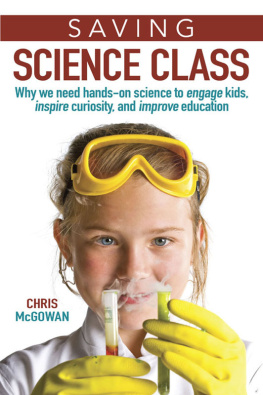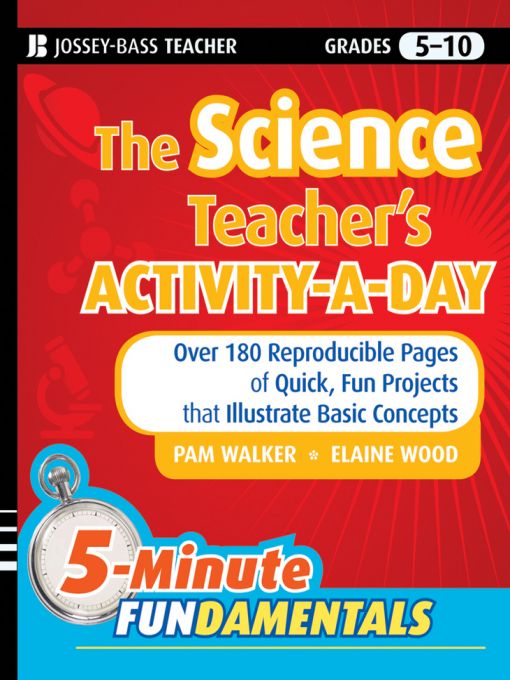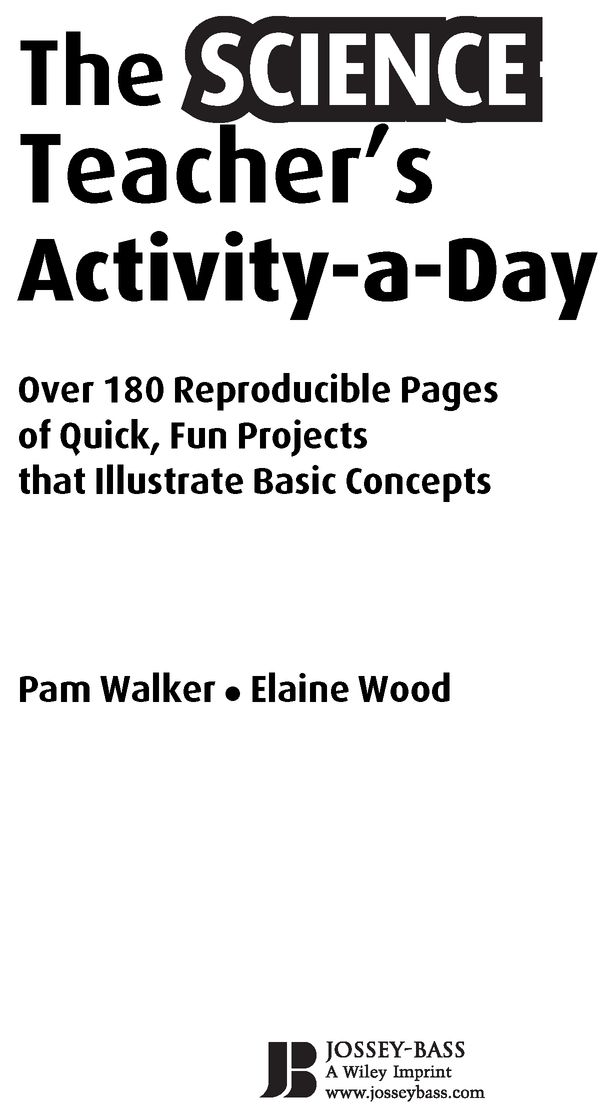Table of Contents
ABOUT THIS BOOK
The Science Teachers Activity-a-Day, by Pam Walker and Elaine Wood, is a book of 180 easy five-minute hook or sponge activities to captivate learners attention. Hook activities are valuable for both the students and the teacher. Research shows that students are most active mentally at the beginning of the lesson. The activities in this book will interest and engage students in the lesson. Students who are interested are more likely to take in and retain information. In addition, hook activities enable students to link prior knowledge to the new topic as well as set goals for learning. For teachers, sponge activities can help reveal any misconceptions that students have on the topic. Through student participation in the hook, teachers find out what students already know on the topic, enabling them to fine-tune the lesson.
This one-of-a-kind book contains hands-on hook activities that are specifically designed for science classes. Starting science class with a fun activity puts the students in a receptive state of mind. Students begin to look forward to the first five minutes of class because they know that something new and interesting is coming their way. The hands-on activities are especially stimulating for kinesthetic learners. Research shows that the majority of students are kinesthetic learners, who learn best by becoming physically involved in the learning experience.
This volume is divided into three units, each of which focuses on one group of National Science Education Standards: physical science, life science, and earth science. In the physical science unit, concepts covered include organization of matter; interactions of matter; energy of motion; heat, light, and sound waves; and magnetism and electricity. Activities in the life science unit cover cells, genetics, evolution, diversity of life, ecology, and body systems. The final unit, on earth science, is composed of activities that focus on the structure of Earth systems, Earths history, meteorology, the universe, and the solar system.
The authors have included activities in this volume that have high interest value, are easy to present to a class, and can be done with inexpensive, easy-to-find materials, such as string, clay, scissors, chalk, and plastic bottles. Most activities can be prepped and ready for class in about five minutes. All activities should be supervised by an adult and students should follow the standard safety rules of science classrooms. The Science Teachers Activity-a-Day can help every science teacher get the lesson off to a dynamic start.
ABOUT THE AUTHORS
Pam Walker and Elaine Wood together have more than forty-five years of science teaching experience. Pam was the 2007 Georgia Teacher of the Year and as such served as a leader in developing science curricula in the state. Both are master teachers in Georgia and hold specialist degrees in science and science education. They are the authors of dozens of books for middle and high school science teachers and students. Their publications include Crime Scene Investigations: Real-Life Science Labs for Grades 6 - 12 and Hands-on General Science Activities with Real-Life Applications.
CORRELATIONS OF ACTIVITIES TO THE NATIONAL SCIENCE CONTENT STANDARDS
| Standard Grades 5 - 12 | Activity |
|---|
| Physical Science |
| Properties and changes of properties in matter | 1.1 | Boyles Gas Law: Marshmallow Under Pressure |
| 1.2 | Buoyancy: Ketchup Packet Cartesian Diver |
| 1.3 | Counting Molecules and Atoms: Number of Molecules of Chalk in Your Signature |
| 1.5 | Chemical and Physical Changes: Examining Paper for Change |
| 1.6 | Physical Properties of Matter: Tootsie Roll Properties |
| 1.7 | Density: Cant Hold a Good Ping-Pong Ball Down |
| 1.8 | Atomic Size in Picometers: Cutting Paper to Atom Size |
| 1.9 | Surface Tension: Why Some Insects Can Walk on Water |
| 1.10 | Birds in Flight: How Birds Wings Enable Them to Fly |
| 1.12 | Volume of a Cylinder: The Long and Short of Volume |
| Chemical reactions | 1.5 | Chemical and Physical Changes: Examining Paper for Change |
| 1.11 | Mendeleevs Periodic Table: It Was All in the Cards |
| 2.1 | Acids and Bases: Cabbage Juice Indicators |
| 2.2 | Polymers: Water-Loving Chemicals in Diapers |
| 2.3 | Freezing Point: Why We Sprinkle Salt on Icy Roads |
| 2.4 | Exothermic and Endothermic Reactions: Hot Packs and Cold Packs |
| 2.5 | Chemical Reactions: Alka-Seltzer and Water Temperature |
| 2.6 | Balancing Chemical Equations: Rearranging Atomic Dots |
| 2.7 | Limiting Reactants: Putting a Halt to the Reaction |
| 2.8 | Writing Ionic Formulas: Equating the Ions |
| 2.9 | Single Replacement Reactions: Turning Iron into Copper |
| 2.10 | Double Replacement Reactions: Trading Partners |
| 2.11 | Polarity and Solubility: Breaking Bonds of Packing Peanuts |
| 2.12 | Surface Area and Solubility: Sweet Solutions |
| Motions and forces | 3.1 | Potential Energy and Kinetic Energy: Bouncing Golf Balls |
| 3.2 | Potential Energy: The Energy of Falling Objects |
| 3.3 | Friction Through a Fluid: Fluids and Falling |
| 3.4 | Newtons First Law of Motion: Inertiathe Magicians Friend |
| 3.5 | Law of Conservation of Momentum: Marble Collisions |
| 3.6 | Static Friction: Going Against the Grain |
| 3.7 | Newtons Second Law of Motion: Acceleration of the Coffee Mug |
| 3.8 | Using the Speed Formula: Speedy Manipulations |
| 3.9 | Newtons Third Law of Motion: What Is a Reaction? |
| 3.10 | Inclined Planes: Making Lifting Easier |
| 3.11 | Levers: First-Class Machines |
| 3.12 | The Three Classes of Levers: Lots of Levers and Lots of Class |
| Transfer of energy and interactions of energy and matter | 1.4 | Identifying and Naming Isotopes: EggCeptional Isotopes |
| 4.1 | Thermal Energy: What Does Temperature Really Measure? |
| 4.2 | Measuring Temperature: Human Thermometers |
| 4.3 | Refraction: A Real Light Bender |
| 4.4 | Concave and Convex Mirrors: An Up-Close Look at the Spoon |
| 4.5 | Magnifying Lens: Water Drop Microscopes |
| 4.6 | Mechanical Waves: The Stadium Wave |
| 4.7 | Transverse Waves: Anatomy of a String |
| 4.8 | Compressional Waves: Making Waves with a Slinky |
| 4.9 | Sound and Its Mediums: Sound Matters |
| 4.10 | Sound Vibrations: Rubber Band Music |
| 4.11 | Sound and Water: Tuning Forks and Water |
| 4.12 | Energy Conductors and Insulators: The Cooks Choice |
| 5.1 | Charging by Friction: Balloons and Dancing Salt Grains |
| 5.2 |




